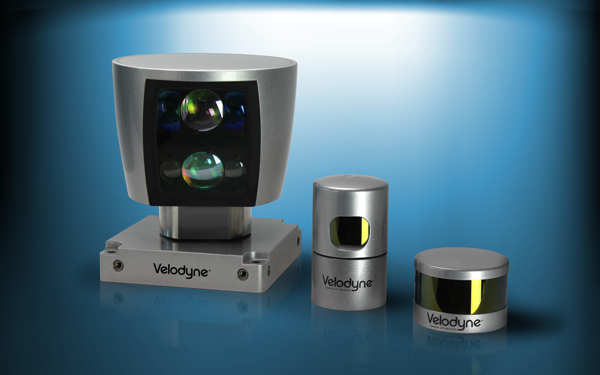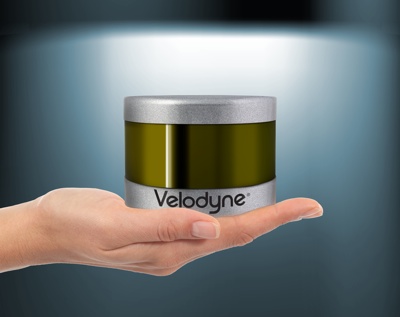Disclaimer: Quotes from Dr. Richard C. Olsen do not imply endorsement by the US Government or DoD. All opinions are strictly his own, and do not reflect the opinion of the USG or US Navy.
Last week Velodyne announced their VLP-16 (also known as the LiDAR “Puck”), a 16-channel real-time LiDAR sensor costing only $7,999 and weighing in at a scant 600 grams. This makes it, as the press release states, “substantially smaller and significantly less expensive than previous generation sensors.”
Wolfgang Juchmann, Director of Sales and Marketing for Velodyne LiDAR, told SPAR that one of Velodyne’s goals while aiming for this price point was maintaining the multi-laser design that Velodyne’s other sensors use. “We wanted to make a multi-line sensor. That’s what the HDL-64E and the HDL-32E, our other LiDAR sensors, are known for—they can do real-time 3D measurement.”
And this multi-line approach is worth maintaining. Richard C. Olsen, director of the US Navy Postgraduate School’s Remote Sensing Center, told me that Velodyne’s multi-line approach made the HDL-64E significantly faster than any comparable terrestrial system when it came out. “The new system,” he says, “still picks up a relative advantage by taking 16 measurements in parallel.”
During our conversation, I asked Juchmann exactly what sort of user Velodyne had designed the sensor for. “There are specific markets we had in mind,” he said. “One is the UAV market, to be mounted on these aerial vehicles for mapping. They are specifically conscious of weight, of size, and also of cost.” This means that a lighter, smaller, and less expensive sensor like the VLP-16 could bring some new users into the LiDAR UAV game.
It’s inexpensive enough that it might even convince those UAV users that are risk-averse. Juchmann asked me to imagine attaching a more expensive sensor to a UAV and then crashing it. “That’s a major problem,” he said. “If you crash an $8,000 sensor, that’s also not very good, but it’s a big difference.”
But is the Puck precise enough for UAV mapping? Yes, according to Juchmann, but it’s not the most precise sensor that Velodyne offers, and it’s not meant to be. “It wouldn’t be survey grade, it wouldn’t be in the millimeter range—it’s in the centimeter range. The VLP-16 is designed with low cost in mind, so there are a few components inside that make the VLP-16 a little bit less accurate than the HDL-32E. So, if your biggest concern is accuracy, you might want to stick with the HDL-32E.”

Side by side: the HDL-64E, HDL-32E, and LiDAR Puck.
Asked if Velodyne had any direct competitors for their new sensor, Dr. Olsen said he doesn’t think there are many. Other low-weight sensors being sold for robotics or automation generally have a range of about 10 meters or so, where the Velodyne sensor has a clear advantage with its range of 100 meters. However, when you speak about sensors for UAV use, Olsen said, another “technology option would be the RIEGL VUX-1, which is significantly more capable, but tips in at 3.6 kilograms.”
Just as it is with any other technologies in this market, the use you have in mind determines the best solution for you.
As impressive as the VLP-16’s spec sheet is, the biggest contribution of Velodyne’s new sensor may be the way it helps to popularize LiDAR technology. By breaking the $8,000 price threshold, Velodyne’s Puck makes the cost of three-dimensional LiDAR justifiable for a whole new batch of users, including warehouse automation companies, agriculture outfits, and the famously cost-sensitive university world, among others. The cost of this 3D sensor is low enough that it now competes with the 2D sensors in common use.
Juchmann explained that this growing market for Velodyne’s LiDAR sensor could help to reduce the cost of their products even more in the future. By selling a less expensive sensor, which might move ten or one hundred times as many units as other sensors, Velodyne begins to benefit from economies of scale. That is, selling more units allows Velodyne to justify investing in automating their own production processes, which will bring prices down even more.
As LiDAR technology continues to break new price thresholds, it remains unclear where we’ll see it pop up next. “The VLP-16 may be a game changer in a community other than the obvious ones,” Dr. Olsen told me. “At this price point, it makes a lot of uses possible that are not practical with more expensive systems.”












